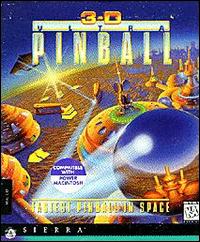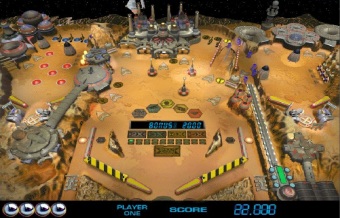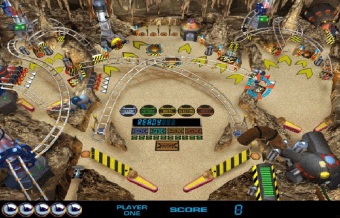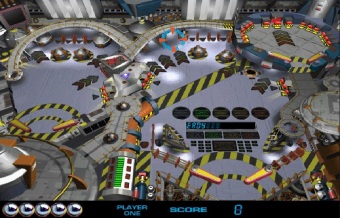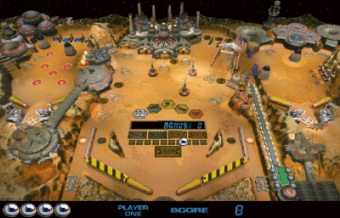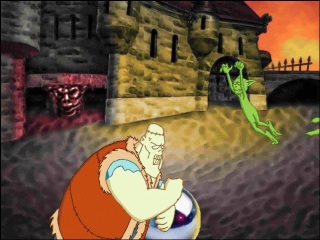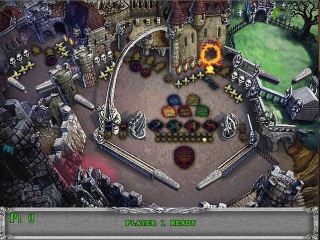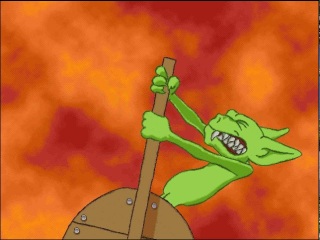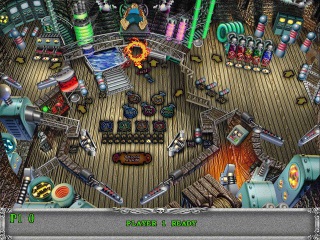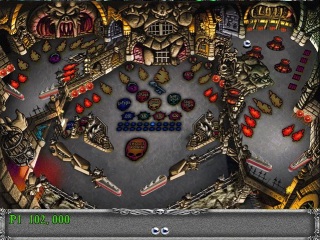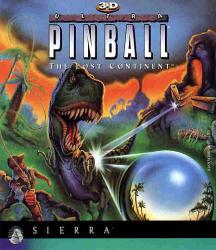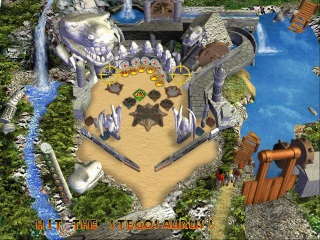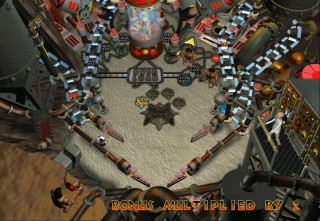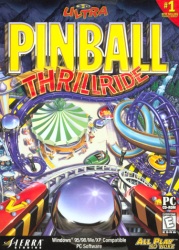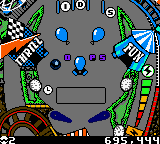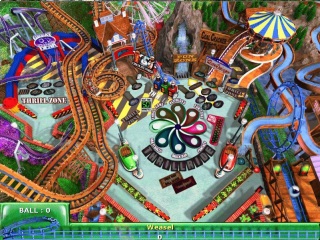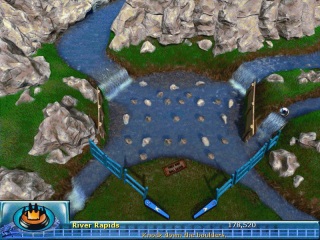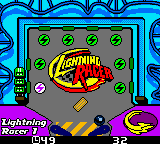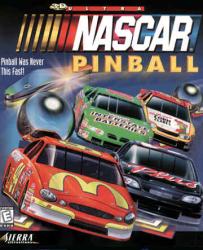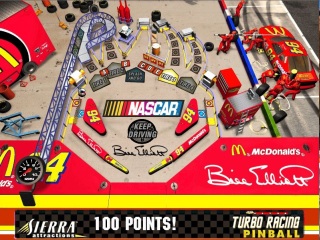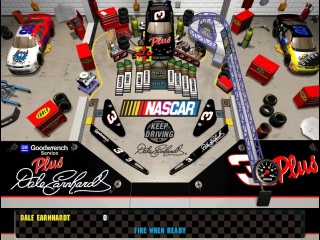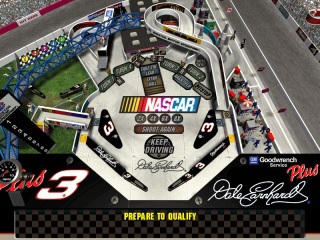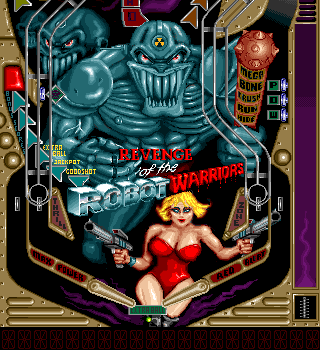
In August of 1995, Microsoft set world records for the launch of their next-generation operating system, Windows 95. Win95 promised computer gamers a smoother experience, making all kinds of claims about its new "DirectX" system, and even going so far as to bundle a handful of multimedia games with the OS, arguably the most popular being 3D Pinball: Space Cadet. While Space Cadet proved popular, what a lot of users didn't quite realize was that this was actually a tie-in marketing ploy by Maxis and developer Cinematronics for their upcoming title, Full Tilt Pinball, which included an enhanced version of Space Cadet as one of its three tables.
Meanwhile, 3-D Pinball was wowing the crowds, almost supplanting previous favorites Solitaire, Freecell, and Minesweeper as the world's premiere desktop time waster. It was about this time that someone at Sierra had a light turn on somewhere: 3D pinball games were a market ripe for the picking.
When 3-D Ultra Pinball was released, the magazine page ads declared dominion over Space Cadet. 3-D Ultra Pinball had not one table, but three (and further tables within those tables), more music, more graphics, more amazing skill shots, and digitized speech and computer-rendered animations to take advantage of its CD-ROM format. The hype machine was in full gear. And the best part, for some, was that Ultra did not require users to buy Windows 95, which considering that Win95 cost $205 at launch and 3-D Ultra Pinball barely priced at $50, was quite the savings.
3-D Ultra Pinball spans three "main" tables - Colony, Command Post, and Mine - and several sub tables, with the option to play the main tables individually or play all of them at once, shifting between tables by completing certain skill shots. The overarching theme of this version is a space colony, actually based on Sierra's previous ambitious (and ultimately failed) strategy game, Outpost. So all of the tables are sci-fi oriented, with the Colony table being on the planet's surface, the Mine being underground, and the Command Post being aboard a space station.
In addition to the pinball action, Ultra has a sort of mini strategy game buried beneath the surface. In Play All mode, completing certain bonus modes and entering the construction building will allow you to build and upgrade structures in the Colony. In doing so, it is possible to eventually build and launch a starship, which effectively wins the game. Otherwise, these buildings really only serve to enhance bonus points and enable some extra modes. Bonus modes often involve extra targets being added to the table, either warping in or folding out of the table like transformer robots. The modes are usually pretty simple; just smack whatever just appeared a few times with the ball and then hit whatever target the game specifies for you (through speech samples and a bulls-eye target).
With as much depth as Ultra has, it's almost inexcusable how bad the ball physics are. The ball floats all over the place like a balloon filled with air, never really feeling like the heavy steel ball that it is. When struck with a flipper, the ball seems to go in almost random directions, making it near impossible to even attempt to aim your shots. The ball has an alarming tendency to get stuck between two jet bumpers for a second or so, which scores a lot of points but makes a horrible racket. Most flipper tricks like juggling do not work due to how overly powerful the flippers are, though it is possible to hold the ball (if it's not already moving too fast by the time it reaches your flippers). It's certainly a helpful gesture, though, that the game will offer you a "bozo ball" if you fail to score any points after launching your ball. Perhaps most aggravating to established pinball players is the uselessness of the table bump feature - meaning if your ball is out of reach of the flippers and about to go down the outlane, you're screwed. One thing 3-D Ultra Pinball does seem to have going for it, though, is its kindness to players with disabilities: you can play the game entirely with two mouse buttons.
Aesthetically speaking, the quality of the 3D rendered tables isn't bad, but given the game's target platform of Windows 3.1 or later, the tables were designed to show at 640x480 and 256 colors, resulting in some graininess and loss of detail. As the ball passes through certain tunnels, you will see the tunnels ripple a bit. Table animations are slightly choppy and the game does not scale up very well at all - while you can maximize the table window to make it larger on higher resolution displays, this results in a pixelated mess and only serves to accentuate the "rippling" effect. It doesn't look pretty, and time hasn't been kind to it, either.
Even as far as sound quality, 3-D Ultra Pinball doesn't seem to have a lot of polish to it - the flippers make a boring little "pop" noise instead of the mechanical clank that a pinballer might be used to. Targets make silly laser sounds, and the table speech tends to repeat itself, which might be good or bad, depending on how good you are at deciphering what the announcer is saying over all the gratuitous echo effects. The music is played through Windows MIDI, which if you're just equipped with a Sound Blaster like most people did back in 1995, has an infuriating tendency to get notes stuck in the middle of a song, resulting in a constant, irritating hum. The only way to stop this is by turning the music off, then back on, then back off again to give the MIDI driver the kick in the teeth it badly needs.
Overall, 3-D Ultra Pinball ultimately doesn't serve to dethrone 3D Pinball Space Cadet, and certainly comes nowhere near Pinball Fantasies. But it started a legacy which would only improve in the coming titles.
Quick Info:
|
Developer: |
|
|
Publisher: |
|
|
Genre: |
|
|
Themes: |
3-D Ultra Pinball (Windows)
3-D Ultra Pinball (Windows)
3-D Ultra Pinball (Windows)
3-D Ultra Pinball (Windows)
The eagerly-awaited sequel to the original 3-D Ultra Pinball brings us to a haunted castle for some spooky goings-on. As with the previous game, Creep Night offers three tables (Castle, Tower, and Dungeon), with the option to play them individually, or together as an all-encompassing metagame.
The Castle table takes place in the courtyard of our standard-issue spooky castle as you fight off zombies, a dragon, and generally try to entertain the ever-present mischievous goblins. The Tower is home to a Frankenstein-esque mad doctor who is trying to reanimate one of the zombies, and his table has you trying to start his machine while bowling over giant rats and playing catch with a squid in a tank (or bonking him in the head). The Dungeon is basically Hell, where you have to manage the "inmates" (skeletons) by bashing them apart with the ball to get them back into their cells.
Even at first glance, Creep Night already looks better than the original game, as it runs at 640x480 in fullscreen mode, but it still tries to stretch up to your desktop resolution, so players may want to turn their screen resolutions down to make the game look nicer. The render quality has improved, as well, with much less of that ugly dithering (despite there being much more color in the tables). The sound is improved as well, with less gratuitous echoing on the speech, better sounds for table elements, and best of all, the music is now digitized instead of playing through the MIDI system. However, much like the previous game, the speech samples do have an occasional moment of repeating themselves - those goblins and their laughing can tend to drive one up the wall, given enough time.
Creep Night is a vast improvement over the original 3-D Ultra Pinball, but overall I don't find its overall theme as interesting as 3-D Ultra Pinball's Outpost theme.
Quick Info:
|
Developer: |
|
|
Publisher: |
|
|
Genre: |
|
|
Themes: |
3-D Ultra Pinball: Creep Night (Windows)
3-D Ultra Pinball: Creep Night (Windows)
Additional Screenshots
The previous two 3-D Ultra Pinball games were quite a success, even if not among the pinball-loving crowd. So of course Sierra, being a great fan of profit in the name of pleasing their fan base, created a third game: The Lost Continent. This game is essentially a combination of Jurassic Park, Indiana Jones, and pinball. What this essentially means: dinosaurs, dinosaurs, and more dinosaurs. The Lost Continent seems to be the only game in the series to attempt to have a story, as the game follows our three protagonists: Rex, an intrepid (and smartalecky) adventurer; his girlfriend, Mary; and an archaeologist, Professor Spector. You'll rarely actually see them in the game outside of a brief glimpse in the introduction video, but their voices are what guides you through the game's various modes.
While the metagame style of the previous two games is retained, the ability to choose your table is not, so every game starts off on Level 1 of the Valley Ruins table. It is astounding how many different tables there are in TLC - according to the help file, there are three "main" tables - Valley Ruins, Lost Temple, and Heckla's Chambers - all of which have at least four "levels" to them. As you complete modes and follow the goals, you'll advance to the next level of your table (which is as good as being a new table in itself). If you're on another level and drain the ball, you'll either be given an option to just lose the ball and stay on the table, or go back one level and keep the ball.
Some deviations from standard pinball have been added; on some tables, the plunger is replaced with a swiveling cannon that is constantly swinging back and forth, allowing players to aim their first shot. The ball can actually land on the various ramps and tracks if the player's aim is good (or lucky) enough. Where most tables would give you a "replay" credit for reaching a certain score or completing certain modes, The Lost Continent actually puts these to use as continues. If you run out of balls, you can continue at Level 1 of whatever table chain you're on. This does reset your score, though, and only your last score counts, so if you got a really high score before continuing, you might want to say "no" to the continue prompt if you have any intention of saving that score.
The Lost Continent uses the same pinball engine as Creep Night, so the game still runs at 640x480 and recommends 256 color graphics, with the screen scaled to fit at higher resolutions. The 256-color dithering doesn't look quite as bad as in the original, and is helped along by a somewhat more limited selection of colors, though the dithering does add some texture to the sandy and rocky portions of the tables.
Of all the improvements, though, Sierra still mostly neglected one recurring problem: speech samples repeat themselves an awful lot. You can now skip the initial speech at the beginning of each table by launching the ball early, but speech in the middle of tables (i.e. to announce special events) tends to go on for a long time and gets repeated enough times that players may get irritated (especially in the case of nearly anything Mary says), though not to as much degree as the goblins in Creep Night.
The Lost Continent is quite an ambitious pinball title, and it would have been a fitting end to the trilogy - except that Sierra had two more titles in line.
Quick Info:
|
Developer: |
|
|
Publisher: |
|
|
Genre: |
|
|
Themes: |
3D Ultra Pinball: The Lost Continent (Windows)
3D Ultra Pinball: The Lost Continent (Windows)
3D Ultra Pinball: The Lost Continent (Windows)
When Americans think of theme parks, most probably think of Disneyland, or Universal Studios, or Six Flags. 3-D Ultra Pinball: Thrillride, however, focuses on one that has maintained popularity since its founding in 1907: Hershey Park in Hershey, Pennsylvania. Yes, the same Hershey that makes candy bars. Yet despite the connection to one of America's biggest proprietors of chocolate, the Hershey product placement in Thrillride is actually quite subtle, in the "blink and you'll miss it" sort of way. Cartoon characters based on Hershey products like Kisses do appear on the scoreboard from time to time, but they don't get in the way, and the focus of Thrillride is really on the rides and the park itself (the game even has some included videos about the history of the real Hershey Park), not on the chocolate.
Thrillride returns to a somewhat more traditional pinball feel, with a more standard style auto-plunger for launching the ball instead of The Lost Continent's swiveling cannon. The goal here is not so much the quest as getting a high score, since the "metagame" is reduced to simply being a vehicle to switch tables. That's okay though, as it makes Thrillride a more accessible game for casual players.
Also helpful for casual players: in addition to the three difficulty settings, Thrillride offers advanced options that let you customize every aspect of the game rules, from the number of balls oper game (anywhere from 1 to 10) to the number of tilt warnings, ball saves, percentage chance of earning extra balls, and frequency of multiball. It also offers the option to add a custom personal message to the game.
Thrillride's graphics engine is updated to run the game at 800x600, with support for High-Color displays, which makes the game look far, far smoother, bringing great benefit to the game's inherently bright and colorful environments (because you wouldn't want a theme park to consist of browns and greys, would you?). The game also now automatically changes screen resolutions instead of scaling to your display, so there is no more pixelation if your monitor is set higher than 800x600.
3-D Ultra Pinball: Thrillride (GBC)
Here's one for the "weird ports" file: Sierra gave Thrillride an adaptation for the Game Boy Color two years later, developed by Left Field Productions (one of only three Game Boy Color games published by Sierra, the other two being casino and card games under the Hoyle license). The Hershey references are made slightly more prominent, and the table layouts have been completely changed to fit in the GBC's smaller screen. Since the GBC is obviously not capable of the "3D" aspect of 3-D Ultra Pinball, the game is instead presented from a scrolling overhead perspective, similar to Pinball Dreams. The table elements still retain their stylish looks, though, with bumper cars being used as pinball bumpers, roller coaster tracks as ball tracks, and park booths like the snack bar being used for ball catchers. The table-spanning metagame is still present, and table switching is yet more frequent than in the original PC version, since the extra tables along the sides of the "main" table obviously couldn't make it as they were. That's certainly not from lack of trying, though, as Left Field obviously put a lot of effort into converting every aspect of the PC version, even down to the cute GBC-style remixes of the original music. Overall, it's actually quite good, even if it's almost nothing like the game on which it's based.
Quick Info:
|
Developer: |
|
|
Publisher: |
|
|
Genre: |
|
|
Themes: |
3-D Ultra Pinball: Thrillride (Windows)
3-D Ultra Pinball: Thrillride (Windows)
3-D Ultra Pinball: Thrillride (GBC)
3-D Ultra Pinball: Thrillride (GBC)
At the time, Sierra owned Papyrus Design Group, responsible for some of PC gaming's finest simulation racing games, like Indycar Racing, Grand Prix Legends, and the NASCAR Racing series. So in perhaps the oddest mash of gaming licenses since Battletoads and Double Dragon, Sierra created the fifth and final 3-D Ultra Pinball game, centering around the NASCAR license.
At the start of the game, you're able to pick which driver to play as. There are four: Dale Earnhardt, Sr. (as this game was published a few years before his unfortunate death), Bobby Labonte, Terry Labonte, and Bill Elliott. This really only affects some of the graphics around each table and what the in-game commentators will say.
Amazingly enough, NASCAR lends itself quite well to the world of pinball, with the various drop targets and bumpers being replaced with piles of tires, tool boxes, garage jacks, and track walls. Your pit crew will talk to you on the radio as you play, telling you about where your ball should go next, as well as teasing the player if they bump the table too much ("Take it easy, it's only pinball!"). Since the tables are actual locations at a NASCAR track (the garage and the track itself), table bumping becomes a bit absurd, since you're essentially bumping an entire mass of land instead of a mere table.
NASCAR's metagame isn't as involved as previous games, but should at least be interesting enough to fans of automobile racing. The usual three-balls-per-game formula actually does not start immediately. When you first start the game, you're in the garage, attempting to fix up your car in time for the race. You only get one ball on this table, and your task is to hit all eight of the spot targets as many times as you can. If you lose your ball here, you're sent to the track to take your qualifying lap. Here, you get 60 seconds to hit targets as they're lit up, and losing the ball merely sends it back to you. Once the 60 seconds are up, the table restarts and normal gameplay is started. Doing well on the qualifying lap gives you a better starting position for the race, which affects bonuses at the end of the ball as well as other factors. While the majority of the action on the track takes place just off the road as you watch the cars race past nearby, it's possible to knock the track walls down and launch the ball into traffic, destroying some of the cars in the process and earning bonuses if you can hit the "HIT HERE" section of the opposite wall. Pit stops are also handled on a separate table, where losing your ball merely sends you back to the track.
NASCAR Pinball borrows the engine from Thrill Ride, so the game now runs at a higher color depth and a resolution of 800x600. It looks much cleaner than the previous few games, and the depth of color helps make the tables look more like the real locations they're supposed to represent.
Sierra also released this game in Europe, but as NASCAR is neither as widespread nor as popular outside of the United States, the game was renamed to 3-D Ultra Pinball: Turbo Racing.
Quick Info:
|
Developer: |
|
|
Publisher: |
|
|
Genre: |
|
|
Themes: |
3-D Ultra NASCAR Pinball Windows)
3-D Ultra NASCAR Pinball Windows)
3-D Ultra NASCAR Pinball Windows)
Outside of pinball, Sierra used the "3-D Ultra" brand for various other games, including 3-D Ultra Minigolf, 3-D Ultra Radio Control Racers, 3-D Ultra Cool Pool, and most bizarrely, 3-D Ultra Lionel Train Town, a virtual train set based on the Lionel line of model locomotives. The 3-D Ultra brand name was retired in 2001, following Sierra's acquisition by Vivendi Universal.
